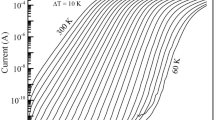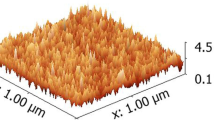Abstract
The metal–insulator–metal diodes have been investigated in which the dielectric consists of two layers: tantalum oxide and alumina, and alumina arises as a result of the interaction of aluminum with tantalum oxide during the deposition of a contact. A technique has been developed for analyzing a diode with a two-layer dielectric in which the thickness of one dielectric layer changes, while the other remains constant. For this case, an algorithm is proposed for dividing the voltage drop on each layer separately and calculating the current–voltage characteristics for each of the layers connected in series. After that, using known methods, it is possible to determine both the characteristics of the material and potential barriers at the interface between the metal and the dielectric.










Similar content being viewed by others
Data availability
The datasets generated during and/or analyzed during the current study are available from the corresponding author on reasonable request.
References
C.A. Reynaud, D. Duché, J.-J. Simon, E. Sanchez-Adaime, O. Margeat, J. Ackermann, V. Jangid, C. Lebouin, D. Brunel, F. Dumur, D. Gigmes, G. Berginc, C.A. Nijhuis, L. Escoubas, Rectifying antennas for energy harvesting from the microwaves to visible light: a review. Prog. Quantum Electron. 72, 100265 (2020). https://doi.org/10.1016/j.pquantelec.2020.100265
N.A. Islam, S. Choi, Bowtie nanoantenna coupled metal-oxide-silicon (p-Doped) diode for 283 THz IR rectification. Nanomaterials (Basel, Switzerland) (2022). https://doi.org/10.3390/nano12223940/
R.L. Bailey, A proposed new concept for a solar-energy converter. J Eng Power 94, 73–77 (1972). https://doi.org/10.1115/1.3445660
S. Grover, G. Moddel, Applicability of metal/insulator/metal (MIM) diodes to solar rectennas. IEEE J. Photovolt. 1, 78–83 (2011). https://doi.org/10.1109/JPHOTOV.2011.2160489
S. Joshi, G. Moddel, Efficiency limits of rectenna solar cells: theory of broadband photon-assisted tunneling. Appl. Phys. Lett. (2013). https://doi.org/10.1063/1.4793425
A. Sharma, V. Singh, T.L. Bougher, B.A. Cola, A carbon nanotube optical rectenna. Nat. Nanotechnol. 10, 1027–1032 (2015). https://doi.org/10.1038/nnano.2015.220
L. Tizani, Y. Abbas, A.M. Yassin, B. Mohammad, M.’d Rezeq, Single wall carbon nanotube based optical rectenna. RSC Adv. 11, 24116–24124 (2021). https://doi.org/10.1039/D1RA04186J
A.Y. Elsharabasy, M.H. Bakr, M.J. Deen, Towards an optimal MIIM diode for rectennas at 10.6 μm. Results Mater. 11, 100204 (2021). https://doi.org/10.1016/j.rinma.2021.100204
A. Alodhayb, A. Meredov, P. Dawar, A simulation study of multi-junction insulator tunnel diode for solar energy harvesting applications. Mater. Res. Express 8, 95509 (2021). https://doi.org/10.1088/2053-1591/ac28b6
D. Matsuura, M. Shimizu, H. Yugami, High-current density and high-asymmetry MIIM diode based on oxygen-non-stoichiometry controlled homointerface structure for optical rectenna. Sci. Rep. 9, 19639 (2019). https://doi.org/10.1038/s41598-019-55898-x
S.B. Herner, A.D. Weerakkody, A. Belkadi, G. Moddel, High performance MIIM diode based on cobalt oxide/titanium oxide. Appl. Phys. Lett. (2017). https://doi.org/10.1063/1.4984278
S. Krishnan, S. Bhansali, E. Stefanakos, Y. Goswami, Thin film metal–insulator–metal junction for millimeter wave detection. Procedia Chem 1, 409–412 (2009). https://doi.org/10.1016/j.proche.2009.07.102
C. Fumeaux, W. Herrmann, F.K. Kneubühl, H. Rothuizen, Nanometer thin-film Ni–NiO–Ni diodes for detection and mixing of 30 THz radiation. Infrared Phys. Technol. 39, 123–183 (1998). https://doi.org/10.1016/S1350-4495(98)00004-8
S. Grover, G. Moddel, Metal single-insulator and multi-insulator diodes for rectenna solar cells, in Rectenna Solar Cells. ed. by G. Moddel, S. Grover (Springer, New York, NY, 2013), pp.89–109. https://doi.org/10.1007/978-1-4614-3716-1_5
S. Joshi, G. Moddel, Simple figure of merit for diodes in optical rectennas. IEEE J. Photovolt. 6, 668–672 (2016). https://doi.org/10.1109/JPHOTOV.2016.2541460
M.N. Gadalla, M. Abdel-Rahman, A. Shamim, Design, optimization and fabrication of a 28.3 THz nano-rectenna for infrared detection and rectification. Sci. Rep. 4, 4270 (2014). https://doi.org/10.1038/srep04270
M.R. Abdel-Rahman, F.J. González, G.D. Boreman, Antenna-coupled metal-oxide-metal diodes for dual-band detection at 92.5 GHz and 28 THz. Electron. Lett. 40, 116 (2004). https://doi.org/10.1049/el:20040105
G. Pacchioni, S. Valeri, Oxide Ultrathin Films (Wiley-VCH Verlag GmbH & Co. KGaA, Weinheim, Germany, 2011). https://doi.org/10.1002/9783527640171
S.B. Tekin, S. Almalki, H. Finch, A. Vezzoli, L. O’Brien, V.R. Dhanak, S. Hall, I.Z. Mitrovic, Electron affinity of metal oxide thin films of TiO2, ZnO, and NiO and their applicability in 28.3 THz rectenna devices. J. Appl. Phys. (2023). https://doi.org/10.1063/5.0157726
J. Müller, P. Polakowski, S. Mueller, T. Mikolajick, Ferroelectric hafnium oxide based materials and devices: assessment of current status and future prospects. ECS J. Solid State Sci. Technol. 4, N30–N35 (2015). https://doi.org/10.1149/2.0081505jss
S.V. Bulyarsky, K.I. Litvinova, E.P. Kirilenko, G.A. Rudakov, A.A. Dudin, Photoluminescence of hafnium oxide synthesized by atomic layer deposition. Phys. Solid State 65, 228 (2023). https://doi.org/10.21883/PSS.2023.02.55405.524
S.V. Bulyarskiy, D.A. Koiva, G.A. Rudakov, G.G. Gusarov, Thermodynamic analysis of stoichiometric composition changes in the Ti × O y films at RF magnetron sputtering and modeling of their conductivity. Phys. Status Solidi (b) (2022). https://doi.org/10.1002/pssb.202100407
S.R. Yousefi, O. Amiri, M. Salavati-Niasari, Control sonochemical parameter to prepare pure Zn0.35Fe2.65O4 nanostructures and study their photocatalytic activity. Ultrason. Sonochemistry 58, 104619 (2019). https://doi.org/10.1016/j.ultsonch.2019.104619
S.R. Yousefi, H.A. Alshamsi, O. Amiri, M. Salavati-Niasari, Synthesis, characterization and application of Co/Co3O4 nanocomposites as an effective photocatalyst for discoloration of organic dye contaminants in wastewater and antibacterial properties. J. Mol. Liq. 337, 116405 (2021). https://doi.org/10.1016/j.molliq.2021.116405
B. Hegyi, Á. Csurgay, W. Porod, Investigation of the nonlinearity properties of the DC I–V characteristics of metal–insulator–metal (MIM) tunnel diodes with double-layer insulators. J. Comput. Electron. 6, 159–162 (2007). https://doi.org/10.1007/s10825-006-0083-9
J. Kübler, K.-H. Höck, H. Böttger, V. V. Bryksin, Hopping Conduction in Solids, VCH-Verlagsgesellschaft, Weinheim, Deerfield Beach-Florida 1985. 398 Seiten, Preis: DM 140, Berichte der Bunsengesellschaft für physikalische Chemie 91 (1987) 77. https://doi.org/10.1002/bbpc.19870910117
I. Nemr-Noureddine, N. Sedghi, I.Z. Mitrovic, S. Hall, Barrier tuning of atomic layer deposited Ta2O5 and Al2O3 in double dielectric diodes. J. Vac. Sci Technol. Nanotechnol. Microelectron. Mater. Process Meas. Phenom. (2017). https://doi.org/10.1116/1.4974219
N. Alimardani, J.F. Conley, Step tunneling enhanced asymmetry in asymmetric electrode metal–insulator–insulator–metal tunnel diodes. Appl. Phys. Lett. (2013). https://doi.org/10.1063/1.4799964
I. Azad, M.K. Ram, D.Y. Goswami, E. Stefanakos, Design and fabrication of metal–insulator–metal diode for high frequency applications, in Infrared Technology and Applications XLIII. ed. by B.F. Andresen, G.F. Fulop, C.M. Hanson, J.L. Miller, P.R. Norton (SPIE, 2017). https://doi.org/10.1117/12.2262618
A. Belkadi, A. Weerakkody, G. Moddel, Demonstration of resonant tunneling effects in metal–double–insulator–metal (MI2M) diodes. Nat. Commun. 12, 2925 (2021). https://doi.org/10.1038/s41467-021-23182-0
R.M. Barrer, Diffusion In and Through Solids (University Press, Cambridge, 1951)
C.J. Smithells (ed.), Metals Reference Book, 5th edn. (Butterworths, London, 1976)
Y. Cui, J. Zhao, Y. Zhao, J. Shao, Diffusion of metal ions from a substrate into oxide coatings. Opt. Mater. Express 6, 3119 (2016). https://doi.org/10.1364/OME.6.003119
A.H. Heuer, Oxygen and aluminum diffusion in α-Al2O3: how much do we really understand? J. Eur. Ceram. Soc. 28, 1495–1507 (2008). https://doi.org/10.1016/j.jeurceramsoc.2007.12.020
D.A. Stewart, Diffusion of oxygen in amorphous tantalum oxide. Phys. Rev. Mater. (2019). https://doi.org/10.1103/PhysRevMaterials.3.055605
W. Li, Y. Ando, S. Watanabe, Cu diffusion in amorphous Ta2O5 studied with a simplified neural network potential. J. Phys. Soc. Jpn. 86, 104004 (2017). https://doi.org/10.7566/JPSJ.86.104004
S. Grover, G. Moddel, Optical frequency rectification, in Rectenna Solar Cells. ed. by G. Moddel, S. Grover (Springer, New York, NY, 2013), pp.25–46. https://doi.org/10.1007/978-1-4614-3716-1_2
S.V. Bulyarskiy, The effect of electron-phonon interaction on the formation of reverse currents of p–n-junctions of silicon-based power semiconductor devices. Solid-State Electron. 160, 107624 (2019). https://doi.org/10.1016/j.sse.2019.107624
J.G. Simmons, Poole–Frenkel effect and Schottky effect in metal–insulator–metal systems. Phys. Rev. 155, 657–660 (1967). https://doi.org/10.1103/PhysRev.155.657
T.-H. Chiang, J.F. Wager, Electronic conduction mechanisms in insulators. IEEE Trans. Electron Devices 65, 223–230 (2018). https://doi.org/10.1109/TED.2017.2776612
M.A. Lampert, Simplified theory of space-charge-limited currents in an insulator with traps. Phys. Rev. 103, 1648–1656 (1956). https://doi.org/10.1103/PhysRev.103.1648
Acknowledgements
This work was supported by the Ministry of Science and Higher Education of the Russian Federation, project No. 0004-2022-0004. The investigations were performed in the Institute of Nanotechnology of Microelectronics of the Russian Academy of Sciences (INME RAS) using Large Scale Research Facility Complex for Heterogeneous Integration Technologies and Silicon+Carbon Nanotechnologies.
Funding
This work was funded by Ministry of Science and Higher Education of the Russian Federation, 0004-2022-0004.
Author information
Authors and Affiliations
Contributions
SVB contributed toward conceptualization, methodology, supervision, and writing—reviewing and editing. AVL contributed toward software, formal analysis, and writing—original draft. APO contributed toward investigation and formal analysis. KIL contributed toward investigation.
Corresponding author
Ethics declarations
Conflict of interest
The authors declare they have no conflict of interests.
Additional information
Publisher's Note
Springer Nature remains neutral with regard to jurisdictional claims in published maps and institutional affiliations.
Rights and permissions
Springer Nature or its licensor (e.g. a society or other partner) holds exclusive rights to this article under a publishing agreement with the author(s) or other rightsholder(s); author self-archiving of the accepted manuscript version of this article is solely governed by the terms of such publishing agreement and applicable law.
About this article
Cite this article
Bulyarskiy, S.V., Lakalin, A.V., Orlov, A.P. et al. Isolation of current–voltage characteristics for each layer of a two-layer dielectric using the example of Al–Al2O3–Ta2O5–Ni diodes with different tantalum oxide thicknesses. J Mater Sci: Mater Electron 34, 2173 (2023). https://doi.org/10.1007/s10854-023-11592-3
Received:
Accepted:
Published:
DOI: https://doi.org/10.1007/s10854-023-11592-3




